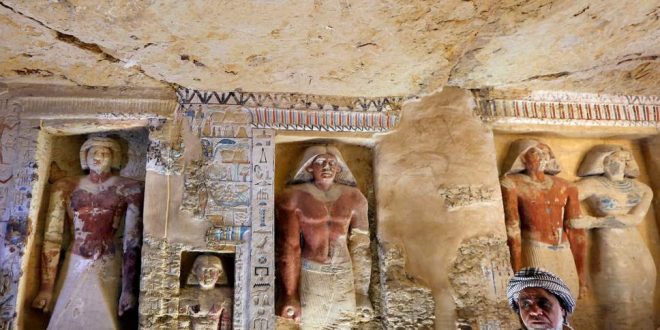Antiquities official say they’ll dig deeper into tomb in search of priest’s sarcophagus
He was known as Wahtye, and served as royal priest or high-ranking religious figure carrying the title “divine inspector.”
And he must have been someone of great importance, for when he was buried in the southwest outskirts of what is now Cairo, his tomb was filled with colourful and elaborate stone carvings that give some sense of the rituals of life and death in ancient Egypt more than 4,400 years ago.
Egyptian antiquities authorities unveiled Wahtye’s tomb at a press conference in Saqqara southwest of Cairo at the weekend, and announced to plans to dig deeper into the well-preserved complex, which was discovered during excavation work that began in April.
The astonishingly well-preserved tomb provides insights into life in the 24th Century BC during the reign of Fifth Dynasty Egyptian King Neferirkare Kakair, a time of relative prosperity and order. Archaeologists are to begin inspecting five shafts that led out from the tomb, believing one will lead to Wahtye’s sarcophagus, which has yet to be discovered.
The chamber’s walls include scenes showing Wahtye with his wife, named Weret Ptah, his mother, and other relatives, as well as depictions of pottery, furniture, and wine production, religious rituals, musical performances, naval vessels, and men hunting animals, according to Egypt’s Ministry of Antiquities.
Mostafa Waziri, secretary-general of Egypt’s Supreme Council of Antiquities, described the discovery as “one of a kind” in recent decades, “The colour is almost intact even though the tomb is almost 4,400 years old,” he reportedly said, according to Reuters.
Nearly two dozen foreign diplomats, members of Egypt’s parliament, and heads of international archaeological missions and institutes attended the unveiling of the tomb on Saturday.
Egyptian authorities have been touting archaeological discoveries in an effort to entice tourists back to the country following years of turmoil ignite by the Arab Spring uprisings.
The tombs at Saqqara, located around 20 kilometres southeast of the Great Pyramid and Sphinx at Giza, though less famous than other Egyptian sites, boast some of the most well-preserved tombs in the nation, with elaborate hieroglyphs and vibrantly coloured stone figurines.
Among the recent discoveries announced at Saqqara were the tomb of a high-ranking military official dating back 3,300 years, a 2,500-year-old mummy wearing a gold and silver mask, and a tomb complex filled with scores of statues depicting cats.
The Independent
 Lebanese Ministry of Information
Lebanese Ministry of Information



